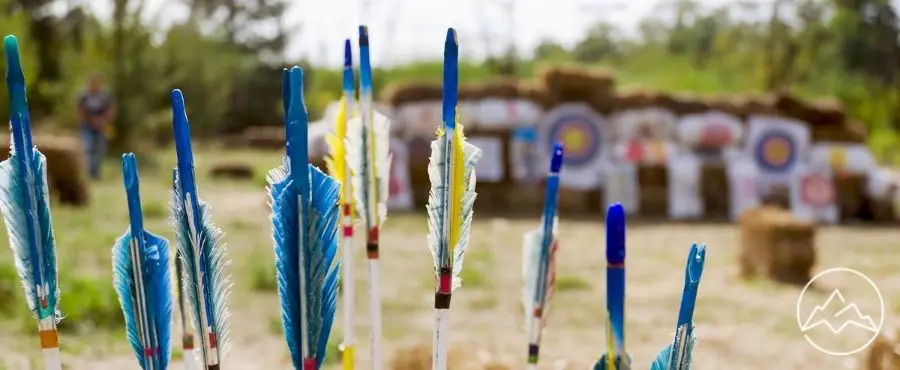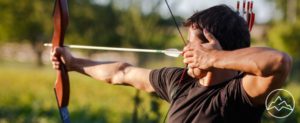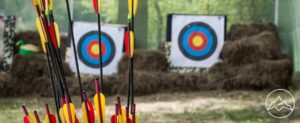In the realm of archery, the choice of arrow fletching plays a crucial role in determining the flight and stability of arrows. Feathers and vanes, the two primary options for fletching, each possess their own distinct advantages and disadvantages. Feathers, with their flexibility and ability to lay flat when shooting, are often favored for their suitability in off-the-shelf shooting. They are lightweight and fold flat upon release, but they require more delicate handling and are less durable. Conversely, vanes offer durability and water resistance, making them ideal for outdoor archery and longer distances. They provide remarkable accuracy, with high-profile options offering increased stabilization and low-profile options better withstanding wind drift. Vanes are cost-effective, durable, and impervious to weather conditions. The choice between feathers and vanes ultimately hinges upon factors such as shooting style, circumstances, aspirations, and the type of bow employed.
Key Takeaways
- Feathers are more flexible and lighter than vanes, making them a good choice for shooting off the shelf and suitable for long-distance shooting.
- Vanes are more durable and water-resistant, offering extreme accuracy and better consistency in outdoor archery and longer distances.
- High-profile vanes provide more stabilization but decrease arrow speed, while low-profile vanes withstand wind drift better.
- The choice between feathers and vanes depends on shooting style, circumstances, aspirations, and the type of bow.
Feathers vs Vanes
Feathers and vanes are both options for arrow fletching, with feathers being more flexible and suitable for shooting off the shelf, while vanes are more durable and water-resistant, making them suitable for outdoor archery and longer distances. Feathers, although lighter than vanes, require more care and are not as durable. They fold flat when the arrow is released and are affected by weather conditions. On the other hand, vanes offer extreme accuracy and come in high-profile and low-profile options. High-profile vanes provide more stabilization but decrease arrow speed, while low-profile vanes withstand wind drift better. Vanes are also cheaper and more durable than feathers, making them better for accuracy and consistency. Additionally, vanes are not affected by weather conditions. When choosing between feathers and vanes, archers should consider their shooting style, circumstances, aspirations, and the type of bow they are using.
Pros and Cons
When considering the choice between feathers and vanes for arrow fletching, it is important to evaluate the advantages and disadvantages of each option. Feathers, although more expensive and requiring more maintenance, offer benefits such as being lighter and folding flat when the arrow is released. They are suitable for long-distance shooting but can be affected by weather conditions. On the other hand, vanes are cheaper and more durable, making them a cost-effective choice. They are not affected by weather conditions and offer better accuracy and consistency. However, high-profile vanes may decrease arrow speed due to increased stabilization, while low-profile vanes withstand wind drift better. Therefore, when considering the cost comparison and impact on arrow speed, archers should carefully weigh the advantages and disadvantages of feathers and vanes before making their choice.
Choosing the Right Fletching
To make an informed decision on the most suitable fletching option, it is crucial to consider various factors such as shooting style, bow type, and desired level of stability and durability. When it comes to fletching durability, vanes have the upper hand over feathers. Vanes are made of plastic or synthetic materials, which make them more resistant to wear and tear compared to feathers. Additionally, vanes are not affected by weather conditions, making them a reliable choice for outdoor archery. Feathers, on the other hand, require more care and are less durable. They can be affected by moisture and extreme temperatures, which may impact their performance. Therefore, if durability and resistance to weather conditions are important factors for an archer, vanes would be the preferred choice for fletching.
Frequently Asked Questions
Can I use feathers or vanes interchangeably on my arrows?
Feathers and vanes can be used interchangeably on arrows, but there are pros and cons to consider. Feathers are more flexible and suitable for shooting off the shelf, but they require more care and are less durable. They are affected by weather conditions and are commonly used in movies and TV shows. On the other hand, vanes are more durable and water-resistant, offering extreme accuracy and consistency. They are not affected by weather conditions and are cheaper than feathers.
Are there any regulations or restrictions on using feathers or vanes in archery competitions?
Regulations on feather or vane usage in archery competitions vary depending on the specific rules of each competition. However, some common guidelines exist. Feathers are traditionally allowed in most competitions, as they have been used for centuries. Vanes, on the other hand, are generally accepted and widely used due to their durability and accuracy. Pros of using feathers include their light weight and suitability for long-distance shooting. Vanes offer enhanced durability and water resistance, making them suitable for outdoor archery. Ultimately, the choice between feathers and vanes depends on the archer’s shooting style and the specific competition regulations.
Can I mix feathers and vanes on the same arrow for improved performance?
Mixing feathers and vanes on the same arrow can be an intriguing experiment for archers seeking improved performance. By combining different fletching materials, archers can potentially benefit from the advantages of both feathers and vanes. This approach allows for a balance between flexibility and durability, as well as stability and accuracy. However, it is important to note that the success of such combinations may vary depending on factors such as shooting style, arrow type, and individual preferences. Therefore, archers are encouraged to engage in careful experimentation and testing to determine the optimal fletching combination for their specific needs.
How often should I replace feathers or vanes on my arrows?
Feathers and vanes on arrows should be replaced when they show signs of wear and tear, such as fraying or damage. The frequency of replacement depends on factors like the number of shots fired, the shooting conditions, and the care taken. To extend the lifespan of feathers or vanes, it is recommended to store arrows in a protected case, avoid exposing them to extreme weather conditions, and regularly inspect and clean them. Additionally, following proper shooting techniques and using arrow guards can help prevent unnecessary damage and prolong their usefulness.
Are there any specific techniques or tips for maintaining and caring for feathers or vanes?
Techniques for maintaining arrow fletching involve proper cleaning and storage. For feathers, it is important to remove any dirt or debris gently with a soft cloth or brush. Feathers should be stored in a cool, dry place to prevent moisture damage. Vanes can be cleaned with mild soap and water, but avoid using harsh chemicals. Storing vanes in a protective case or tube can help prevent bending or warping. Regular inspection and replacement of damaged fletching is essential for optimal performance.
Conclusion
In conclusion, the choice between feathers and vanes for arrow fletching ultimately depends on various factors such as shooting style, circumstances, aspirations, and the type of bow. Feathers offer flexibility and are suitable for shooting off the shelf, while vanes provide durability and water resistance, making them ideal for outdoor archery. The decision should be made based on the desired level of accuracy, consistency, and the ability to withstand weather conditions. Ultimately, the perfect arrow fletching is the one that aligns with the archer’s needs and preferences, ensuring optimal performance on the archery field.












